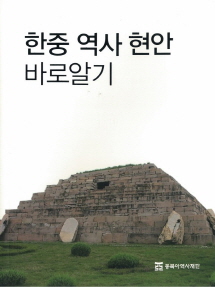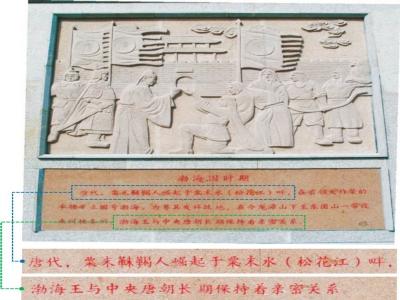- Koguryo and Balhae
- Korea-China History Awareness
Koguryo and Balhae

1. History in Dispute

▲ Historically inaccurate relief and description. (Koguryo relief, Yongdam Mountain Fortress, Jilin City, Jilin Province, China)The description falsely states that Koguryo was a part of China's administration.


▲ Historically inaccurate relief and description. (Balhae relief, Yongdam Mountain Fortress, Jilin City, Jilin Province, China)The scene depicted in the relief falsely implies that Balhae was founded through an issuance of jarlig (imperial decree) by the Tang dynasty. The inscription below describes the founding forces of Balhae to be the Mohe (Tungusic people in ancient Manchuria) as part of the Tang dynasty's administration.

Despite the bilateral agreement between South Korea and China, however, the publicized results of the Northeast Project were discovered to have proliferated considerably. On September 10th, 2006, then-president Moo-hyun Roh raised this issue to Premier Jiabao Wen and President Jintao Hu of the People's Republic of China for corrective action. The two leaders of China promised to fully honor the verbal agreement. And in February 2007, the planned five-year Northeast Project ostensibly came to an end.
Terms of the Korea-China Verbal Agreement
The agreement included the following five points:
① The Chinese government shall be considerate of the magnitude of the Koguryo history issue between the two nations.
② Efforts shall be made to prevent damage to the amicable Korea-China relations and develop a cooperative partnership regarding Koguryo history issues.
③ Both nations shall promote a fair resolution of Koguryo history issues and take necessary measures to prevent political complications.
④ China shall, at the central and local government levels, be compassionate toward Korea's interests in Koguryo history-related technologies and take necessary measures to prevent further dissolution regarding Koguryo history issues.
⑤ Both countries shall seek resolution through swift academic exchange.
These research results have proliferated throughout the scientific community and into Koguryo and Balhae historical sites, museum labels, and college textbooks and other educational materials. And now, the Northeast Project has moved beyond the realm of professional scholars and into China's general population to change the perception of history.
If the Northeast Project can be generalized as a recognition of Gojoseon, and Koguryo and Balhae history as parts of Chinese history, then not only is the project still ongoing, but its termination is uncertain. East Asian history has developed through reciprocity between nations, and it will continue to do so. Now, these nations must write history through reconciliation and cooperation on a foundation of facts. To do so, people need to know exactly what is historical fact. This is the only way to contend with the distortion of history and maintain historical integrity. The purpose and main arguments of the Northeast Project need to be analyzed so as to identify the problems and prepare measures to confront its fallacies.
The Northeast Project
The Northeast Project, short for Serial Research Project on the History and Current State of the Northeast Borderland, was a research project conducted by the Research Center for Chinese Borderland History and Geography under the guidance of the Chinese Academy of Social Sciences (CASS) that lasted for five years beginning on February 28th, 2002. The principal purpose of the research project was to study the past history and current situation surrounding three provinces (Heilongjiang, Jilin, Liaoning) in China's northeastern region.
닫기
Table of Contents Open Contents
- History in Dispute
- The Northeast Project: Intent and Contrivance
- China’s Claims and Korea’s Perspective
- The Northeast Project: Impact and Response
- Details of the Northeast Project and its Research Results
- Northeast Project Reference List










